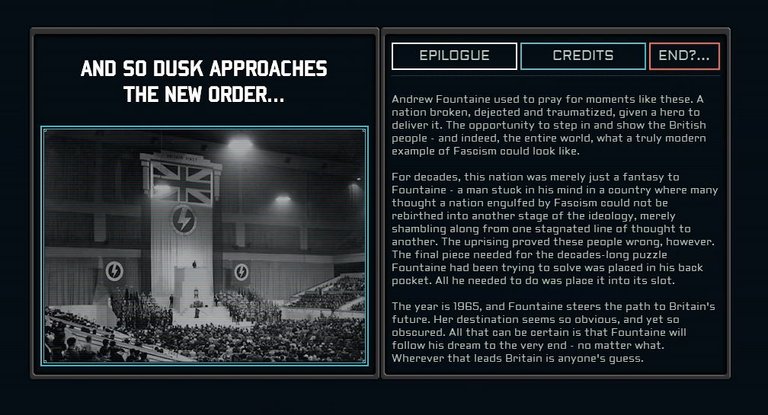The newest update for The New Order, one of the most popular Hearts of Iron IV mods, adds new content related to the two opposite corners of Europe suffering under the Teutonic jackboot: Ukraine and Great Britain. Let's take a look at what life looks like among the titular Ruins — the ashes of the once proud and mighty British Empire.
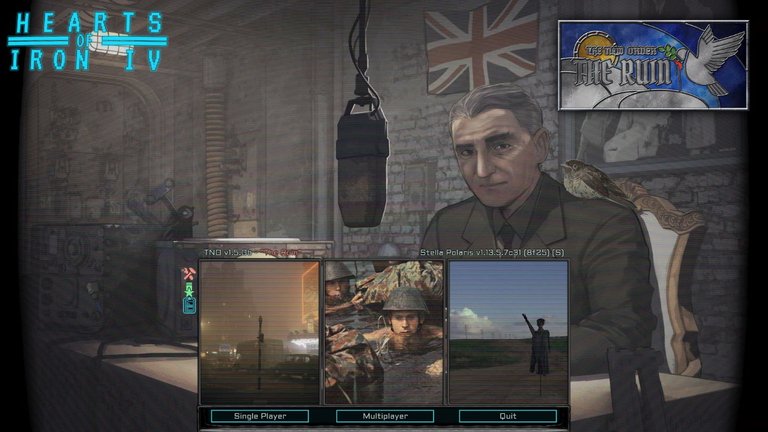
All screenshots were taken by myself. Some pictures in this post are screenshot compilations and do not exactly represent what the players sees in the game.
In TNO's alternative timeline, the Second World War was going quite tolerably for the British... until it wasn't. For reasons only barely explained by the dev team, Nazi Germany managed to crush the ugly head of the Soviet beast and followed that victory with a successful landing on the British Isles in March 1945. Despite the support of American and other allied troops, the desperate defensive battle fought in Northern Ireland was lost and the swastika flag flew over London. Under the terms of the Treaty of London imposed by Hitler, the United Kingdom became, as the words of the treaty deceitfully put it, "a free country under the aegis of the German Reich". Although the leader of the British fascists, Sir Oswald Mosley, had been executed for treason while the war was still going on, the Blackshirts formed a collaborationist government together with mainstream conservative politicians. In conclusion, a new order was imposed on the British populace. Left-wing and antifascist opposition was brutally suppressed while nearly all British Jews were deported by the Germans somewhere in the eastern frontier of Europe and never heard about again. Overseers sent by Berlin are still staying in the country and controlling its government.
The British Empire has fallen. Yet millions still live.
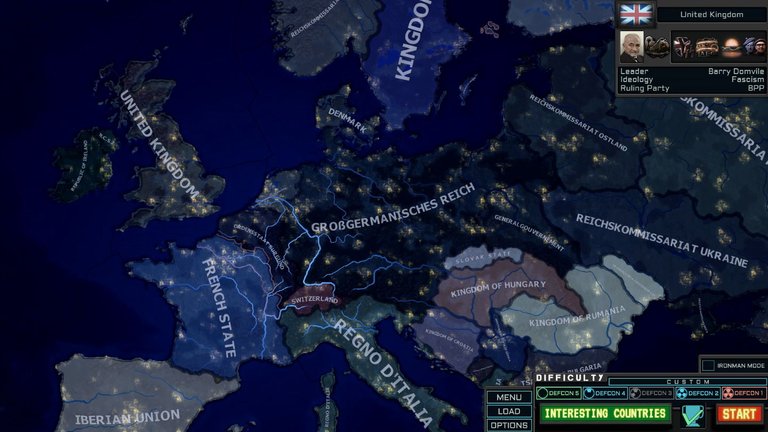
An elusive resistance movement remains active in the entire country. It took up the name of Her Majesty's Most Loyal Resistance, or HMMLR. Declaring their loyalty to Queen Elizabeth who stays in Canada as an exile, the rebels are trying to undermine the unstable government of Hitler's lackeys. The resistance managed to launch a country-wide uprising back in 1956 but it was drowned in blood by the collaboration government of A. K. Chesterton, a bona fide fascist. The HMMLR managed to avoid destruction and stays in the shadows, waiting for an opportunity for another rebellion. Meanwhile, the German tyrant is growing older and his health deteriorates.
A rather fragile New Order: The beginning
Like every other TNO scenario, the playthrough begins in 1962. The leader of the British People's Party, the only legal political party in Britain, is facing challenges that would make a lesser man weep. Prime Minister Barry Domville rules over a country still recovering from a lost war and rebuilding its economy. Another problem to handle is the factionalism within the BPP, but the looming resistance movement is an even bigger threat. The first thing to do after starting the game is to tackle the danger of another uprising. After gaining the support of the party and winning the approval of the German overlords, Domville releases the so-called Freedom of Security Act, a new law which even further restricts the personal freedom of citizens and gives more power to various security agencies, mainly the MI5. Through this decision, the prime minister hopes to finally eliminate the remnants of Old Britain.
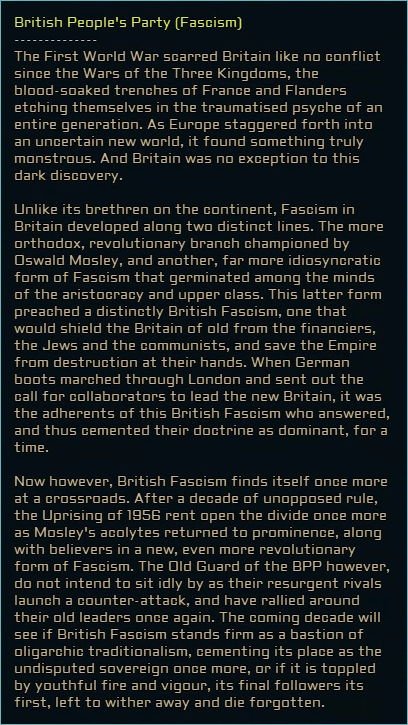
In-game description of the governing party
Workshop of the World: The economy
Another pressing issue is Britain's economic situation. Although the previous collaborationist governments managed to stabilise a country devastated by the world war and the rise of HMMLR, the British economy is still fragile. The government's idea of remedy is to accomplish two major economic projects: the Thames Eastern Airport and the Severn Barrage. Using a special Workshop of the World screen, the player can see what conditions must be met to complete the projects and how much time is left. We can also decide how many Production Points to allocate to the development of each project. The second page of the screen shows Britain divided into regions and the ownership structure in each region (state-owned companies, private companies, and German corporations), as well as the influence of the individual Nazi megacorporations. With various decisions, we can increase the state's share of the economy or, on the contrary, support the private sector and strengthen the position of individual corporations.
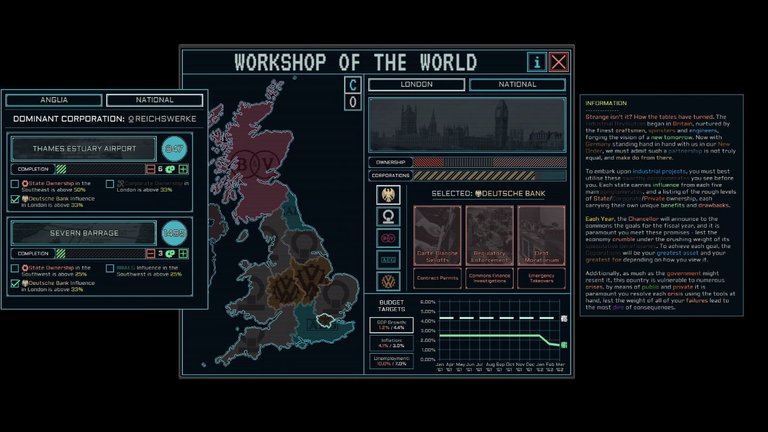
Waiting for the worms: Party politics
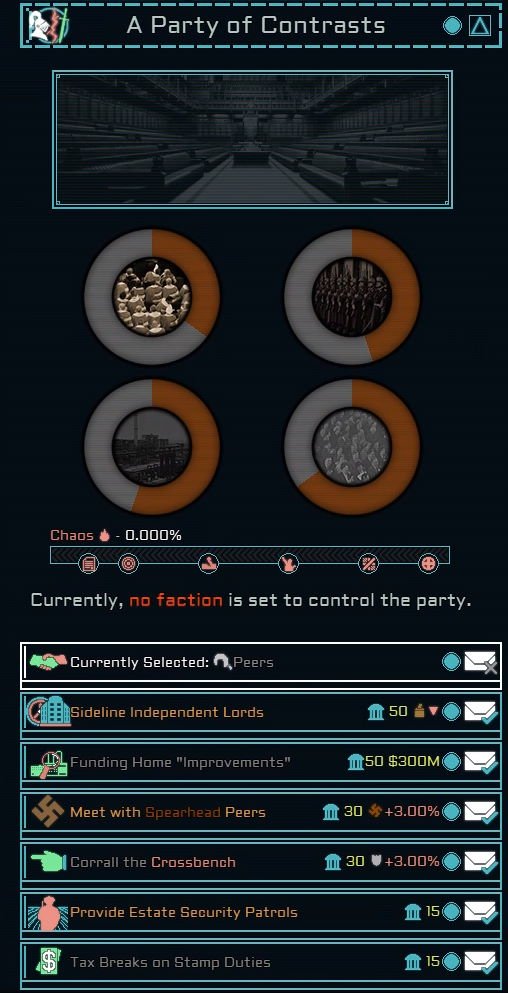
Britain doesn't live by economy alone. The ruling party is plagued by factional divisions that are adding to the political chaos. Prime Minister Domville himself heads the Old Guard, a conservative group that is primarily concerned with maintaining the shaky status quo. Within the party, however, there are two other opposing currents. At one end of the spectrum is the moderate faction, the Pragmatists, which has set itself the goal of gradually reforming the system and making it less oppressive, as well as winning more independence from the Reich. Their fierce opponents are the Ideologues, a group of true believers in British Fascism. With Andrew Fountaine at the helm, they strive for the return to the early ideals of a fascist revolution and the complete transformation of British society. At this point, the game introduces a new mechanic which lets the player empower one of the factions — at a cost.
The new screen shows the influence of factions in four different sectors: the House of Peers, the Nazi garrison and German megacorps, and then, within the Party itself. By spending political power, it's possible to use various options to increase the influence of a particular group in a sector. For example, a meeting with the Spearhead radicals will strengthen the Ideologues. However, such actions do not benefit the political order because of the chaos mechanics. It is an abstract representation of the turmoil prevailing on the British political scene. Some decisions can contain its level to a degree, including removing the worst radicals from the ranks of the BPP but some damage can never be mended — the Chaos bar shows seven thresholds and after it passes one, there's no going back. Besides, the anti-chaos measures take some time to become effective and it may be too late to prevent another stage of disorder.
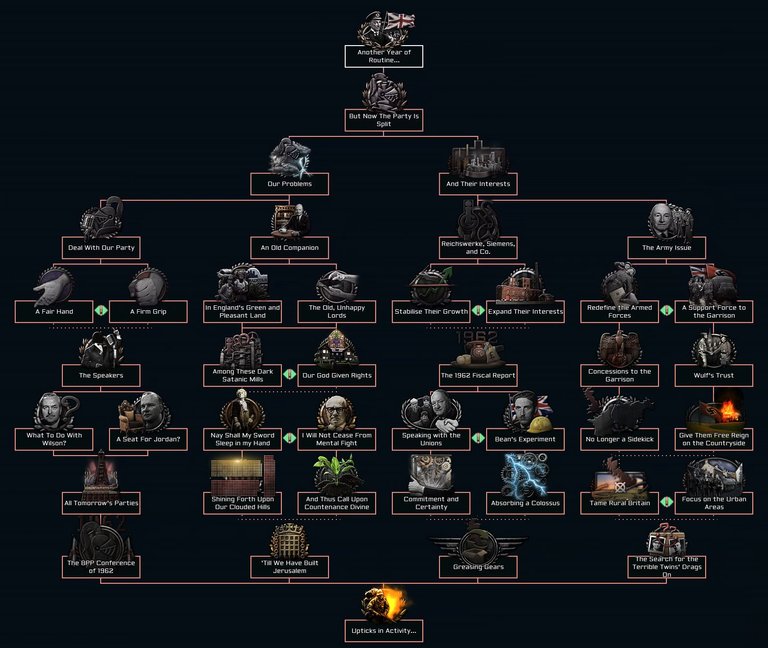
The factional struggle is also influenced by a new decision tree that allows the player to deal with domestic politics. The focuses deal with discipline within the ruling party and the balance of power between factions, but we also decide on relations with German business, the role of trade unions and, ultimately, the direction in which the British armed forces are to develop. The chosen focuses, of course, affect the economy, the functioning of different regions of Britain and, above all, the influence level of Pragmatists and Ideologues.
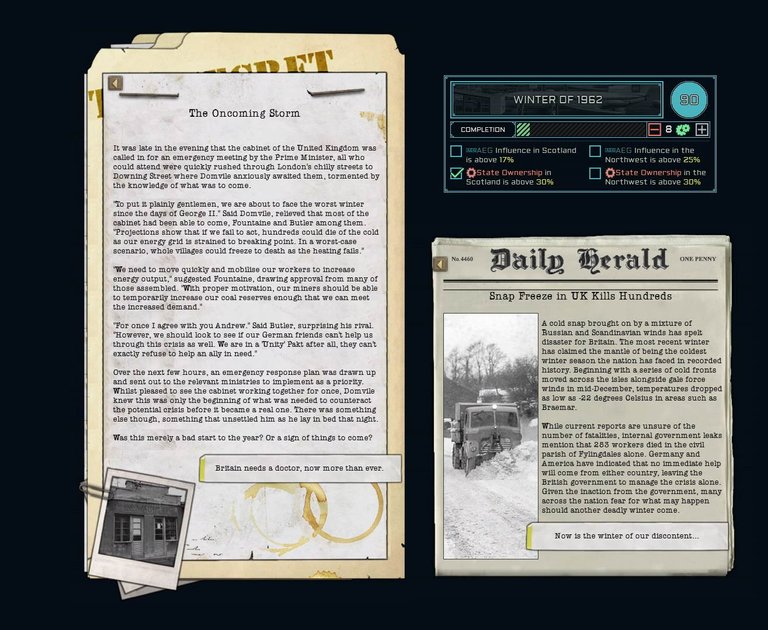
To make things even more interesting (and frustrating), Britain will have to face a threat coming from Mother Nature herself. In Autumn 1962, Domville calls the government to an emergency meeting to discuss the coming winter. According to all forecasts, it is going to be the worst winter since the beginning of the century. A new project appears in The Workshop of the World screen, a government campaign aimed at preparing the country for the incoming crisis. Just like in the case of the other big projects, the player needs to allocate production points and reach certain levels of state ownership and corporate influence in the northern part of Britain. Time is short as the British have only three months before the disaster arrives. Failure will, of course, weaken the economy, stability and the position of the ruling party.
To sum up all of the above, Domville and his party are facing enormous challenges, but play your cards right and you'll manage to keep the economy afloat, curb down the resistance, and keep the Party reasonably functional. At one moment, it may even start to look like there's a thin light shining among the darkness of conquered and humiliated Britain.
Then the old man in Berlin finally dies. And the edifice of the European New Order comes crashing down.✅
Spectre of Cromwell: The Second British Civil War
The tyrant has named his official successor, but his rivals, the most powerful actors in German politics, refuse to accept him. The Reich becomes paralysed by the ensuing chaos and the British government now stands alone — while the resistance is surely planning to use the opportunity. The new emergency tree gives the player options to do some damage control. There is an option to reach out to the Führer in spe and his German representative in London, as well as to mobilise the British Free Corps, an extremist militant group supporting hardline fascism. Typically for TNO, the tree is a bait, though. It can never be finished without cheating and is used as a narrative tool to highlight the hopelessness of the situation. After just a few focuses are completed, London is struck by a lighting, almost literally.
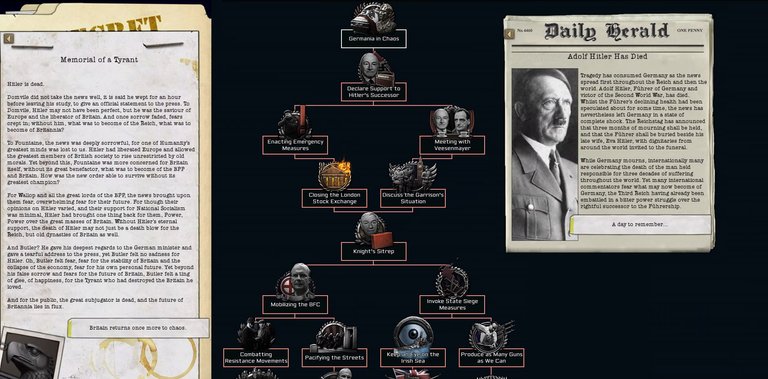
A package arrives at Downing Street, sent by a young, patriotic woman who would be known as the Iron Lady in another timeline. The dead body of the prime minister is found among the smoking rubble. At the same time, the MI5 headquarters turns out to be completely empty. After its counterintelligence service defected to the enemy, the government is left blind when an armed rebellion engulfs most of the country.
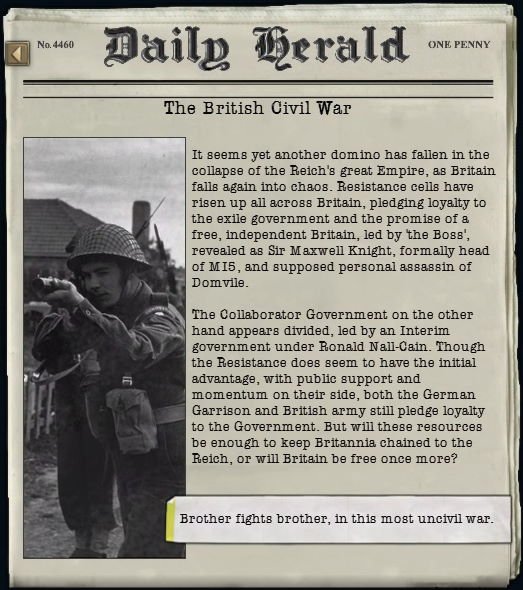
The rebels have taken Wales, Cornwall, East Anglia and most of Scotland. A large group of loyalist troops has been surrounded in the Edinburgh area. A quick retreat into the city is the only sensible decision — the capital of Scotland will become the Stalingrad of this war. Most insurgents are little more than armed rabble, worker militias and similar but some HMMLR troops consist of battle-hardened veterans of previous conflicts, led by the elite soldiers of Special Operations Executive. The forces loyal to the government have a similar composition. Most troops are either poorly trained and equipped regular army or Home Guard militiamen. The most valuable asset is the German garrison with its Panzer divisions which will form the spearhead of the collaborationist army. This is the only help the London government can expect from its conquerors since Germany herself is engulfed in civil war. In fact, all of the Reich's dependencies in Europe are collapsing and the only stable part of the Reich is Burgundy, Himmler's secretive fiefdom, but to ask him for help would be madness.
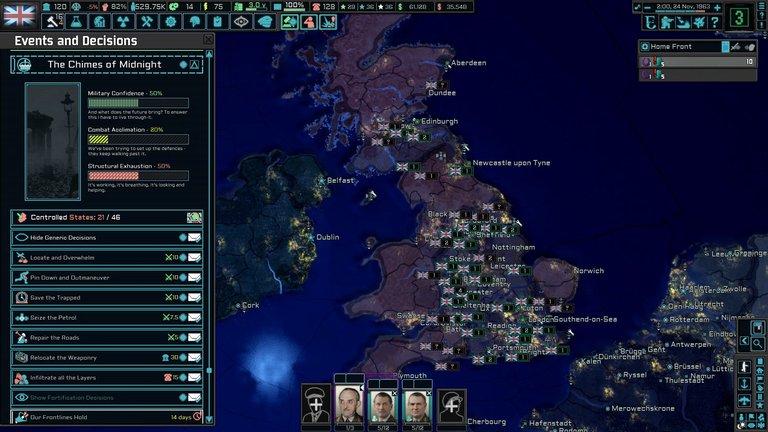
While trying to stop the rebel tide, the player has to deal with new special mechanics. The three bars at the top of the decisions screen refer to the state of the high command, the general effectiveness of the army, and the situation in terms of logistics and infrastructure. The first variable is actively used to give various bonuses to the fighting troops while the other two mostly determine passive buffs or penalties.
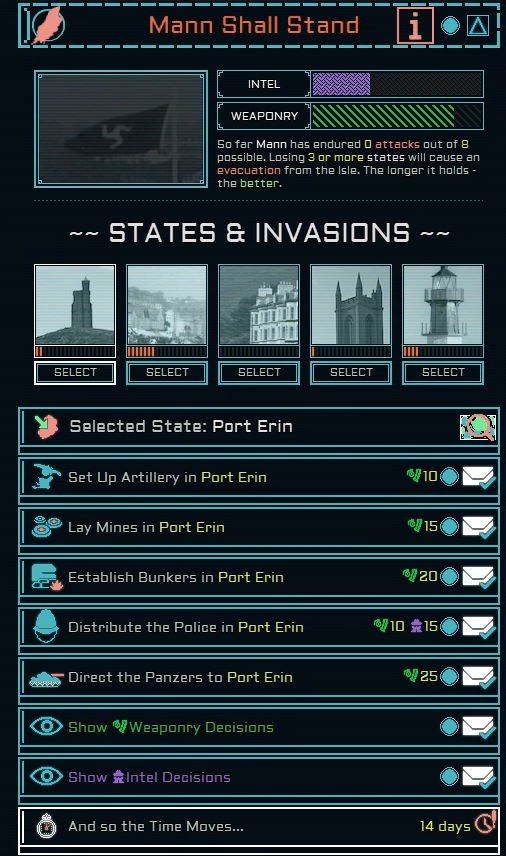
This civil war has its second, quiet front. The Isle of Mann, located in the Irish Sea, becomes the priority target for the HMMLR. By seizing it, the rebels would be in a better position to receive American aid. Even though the local garrison is weak, its commander refuses to evacuate and builds up the defences. The first task is to enforce the key defensive positions on the island by setting up minefields or building bunkers. The second, more important task means playing a game of hide and seek with the insurgents, trying to predict their attacks and also manipulate them into hitting the strongest defensive point. Preparing a successful defence obviously requires arms and supplies which will be taken from the troops fighting in Britain. The decisions to make are difficult since it is almost impossible to survive all attacks and hold the island. On the other hand, the longer Man remains in the government's hands, the less American aid will be sent to the rebels. Moreover, even if the garrison is forced to retreat, the player will receive various bonuses depending on how many attacks have been repelled.
To Weed Out the Weaklings: Winning the civil war
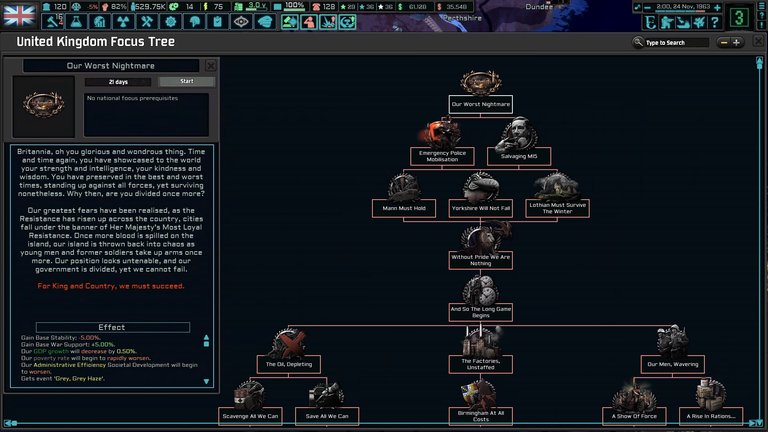
In the beginning, the position of the government forces is getting worse from one hour to another. The insurgents have cut off Scotland from the rest of the loyalist territory and taken over Cornwall, Wales and East Anglia. Now they are threatening to capture the industrial heartland of England and their forces are crawling towards the capital. The dire situation is reflected by the wartime focus tree, showing the desperate measures taken by the government to stop the rebel advance.
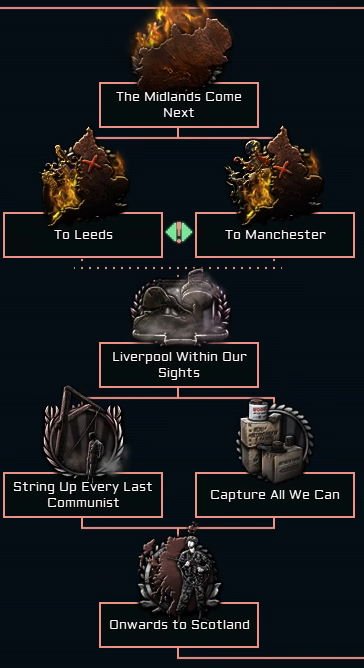
If the leadership is competent, it's possible to survive the first onslaught and slowly turn the tide. Defence lines get organised around the industrial centres and a special assault group made of the strongest units, especially German armour, crushes the insurgents in the eastern pockets. Then it is relocated west to liberate Wales and Cornwall. Finally, a single frontline remains in the north. The loyalists are slowly pushing the enemy away and, if they are quick enough, manage to relieve the besieged garrison in Edinburgh. Eventually, a new focus tree will let the player claim the spoils of war. If a region is captured quickly enough, it is possible to complete a corresponding focus and receive a bonus in manpower, military experience, and so on. Stalling the war and failing to complete objectives gives penalties.
The Shots Fall Silent: The post-war finale
The government has prevailed against all odds and the HMMLR is no more. A series of event texts show the fate of the rebel remnants who are being hunted down, one group after another. The leaders of the insurrection are captured, judged, and executed without any mercy. Then the post-war focuses let the player determine the fate of the veterans, make decisions to reconstruct the wartorn country, and, most importantly, decide which group will rule Britain for the coming years.
Should Andrew Fountaine and his radicals prevail, Britain will undergo a true fascist revolution. The Ideologue government hates the old upper-class elites for failing to prevent the civil war and betraying the ideals of British Fascism. The leaders of yesterday lose their power while the new government made by the radical faction undertakes a complete transformation of the British society and economy. One look at their tree is enough to tell how Britain and its people are being moulded into something new and unrecognisable.
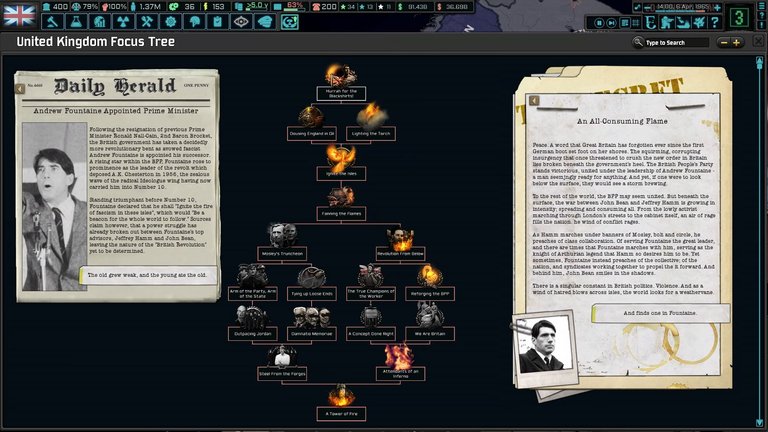
There are other possible outcomes. Rab Butler's Pragmatists will make an attempt to make Great Britain a more democratic and humane country. Should the level of chaos within the British People's Party rise too high, Fountaine will be sidelined by Gerard Wallop, an eccentric member of the Fascist Old Guard. Depending on the decisions made by the player, the new prime minister will either completely return to the policies from before the civil war or introduce the Social Credit system, an idiosyncratic ideology which aims at turning the clock back and turning Britain into a rural utopia. Finally, if the governing party is totally torn apart by the inner struggle, the government will be coupled by the British Free Corps extremists.
Sadly, no matter which group takes the power, this is the point where the new content ends with a short epilogue text. While other countries like Germany, Italy, or the US can be fully played for 10 in-game years at least, this is not the case with Britain at the moment. The development has obviously promised full content for all the collaborationist paths but it remains unknown if and when it will be released.
